Oral Session
Diagnosis & Treatment of Neurological Disorders
Joint Annual Meeting ISMRM-ESMRMB & ISMRT 31st Annual Meeting • 07-12 May 2022 • London, UK

| 14:30 | 0485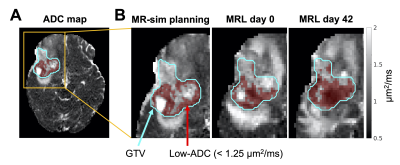 |
Dynamics of hypercellular glioma regions identified with diffusion-weighted imaging for adaptive radiotherapy on an MR-Linac
Liam S. P. Lawrence1,2, Rachel W. Chan1, James Stewart3, Mark Ruschin3, Aimee Theriault3, Sten Myrehaug3, Jay Detsky3, Pejman J. Maralani4, Chia-Lin Tseng3, Greg J. Stanisz1,2,5, Arjun Sahgal3, and Angus Z. Lau1,2
1Physical Sciences Platform, Sunnybrook Research Institute, Toronto, ON, Canada, 2Department of Medical Biophysics, University of Toronto, Toronto, ON, Canada, 3Department of Radiation Oncology, Sunnybrook Health Sciences Centre, Toronto, ON, Canada, 4Department of Medical Imaging, Sunnybrook Health Sciences Centre, Toronto, ON, Canada, 5Department of Neurosurgery and Paediatric Neurosurgery, Medical University, Lublin, Poland
For radiotherapy of high-grade glioma, dose escalation to hypercellular tumour could improve local control, but changes during treatment might necessitate target volume adaptation. Since hypercellular tumour causes low apparent diffusion coefficient (ADC) values, volumetric changes in low-ADC regions were quantified using near-daily MR-Linac imaging to evaluate adaptation necessity. Low-ADC regions increased in volume (median extremal change: 12.2%) and changed rapidly for certain patients (maximum growth/shrinkage rate: 7.1/9.1% per day). Low-ADC regions changed more in magnitude and grew more rapidly for resected tumours than intact ones. These findings imply that adaptation may be required for dose escalation to hypercellular glioma regions.
|
|
| 14:42 | 0486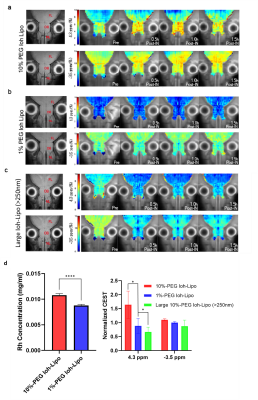 |
Develop CEST-detectable liposomes for nose-to-brain drug delivery
Lok Hin LAW1, Jianpan Huang1, Yang Liu1, Peng Xiao1, Ho Chi Joseph Lai1, Zilin Chen1, and Kannie W.Y. CHAN1,2,3,4
1Department of Biomedical Engineering, City University of Hong Kong, Kowloon, Hong Kong, 2Russell H. Morgan Department of Radiology and Radiological Science, Johns Hopkins University School of Medicine, Baltimore, MD, United States, 3City University of Hong Kong Shenzhen Research Institute, Shenzhen, China, 4Hong Kong Centre for Cerebro-Cardiovascular Health Engineering (COCHE), Hong Kong, Hong Kong
Nose-to-brain-drug-delivery is an effective route to administer drug to the brain bypassing the blood-brain-barrier(BBB). No non-invasive way to assess the delivery-efficiency available yet, especially with brain distribution. Here we investigated the imaging of nanomedicine-delivery via intranasal-administration using CEST-detectable(Iohexol loaded)mucus-penetrating-liposome(with10%PEG). The mucus-retention and penetration-efficiency was examined by in-vitro cell study and in-vivo CEST MRI after injecting the Iohexol-loaded-mucus-penetrating-liposome(Ioh-Lipo). 10%PEG-Ioh-Lipo showed a 20%higher mucus-retention than 1%PEG-Ioh-Lipo. This was also observed in-vivo with significant CEST-contrast difference in the OB between 3groups of mice at 4.3 and 3.5ppm. Moreover, liposomes were mainly found in the ONL, EPL, and MCL of the OB in histology.
|
|
| 14:54 | 0487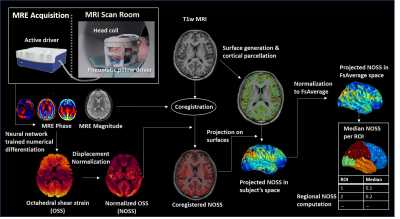 |
MRI-based cortical shear strain measurement in healthy volunteers: repeatability study and its implications for sub-concussive trauma
Xiang Shan1, Matthew C Murphy1, Yi Sui1, Keni Zheng1, Armando Manduca2, Richard L Ehman1, John Huston III1, and Ziying Yin1
1Radiology, Mayo Clinic, Rochester, MN, United States, 2Physiology and Biomedical Engineering, Mayo Clinic, Rochester, MN, United States
Repetitive head impact (RHI) increases the risk of concussion, probably due to alterations of the brain-skull mechanical coupling. It would be of clinical value to have a reliable biomarker capable of assessing the status of the brain-skull coupling condition. MRE-based normalized octahedral shear strain (NOSS) has been proposed as a method for such brain membrane system evaluation. To verify the test-retest reliability of NOSS, datasets from 14 healthy volunteers were acquired with different vibration directions and within- and between-day scanning. This study demonstrated the excellent repeatability of the proposed method, showing the NOSS distributions were robust to loading variations.
|
|
| 15:06 | 0488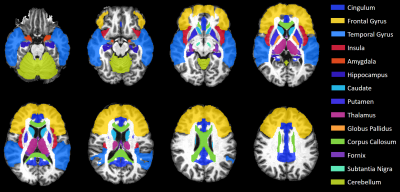 |
DKI Metrics Provide Improved Sensitivity To Conventional DTI in Differentiating Brain Microstructural Changes in HIV Clade-C Infection
Teddy Salan1, Sameer Vyas2, Deepika Aggarwal2, Paramjeet Singh2, and Varan Govind1
1Radiology, University of Miami, Miami, FL, United States, 2Post Graduate Institute of Medical Education & Research, Chandigarh, India
HIV clade-C, found in 50% of HIV cases worldwide, has been reported to have lower neurovirulence than clade-B, more common in the global north. Numerous DTI-based studies have investigated HIV-associated microstructural damage in the brain, yet few looked at clade-C in particular. Moreover, some have reported inconsistent DTI results with respect to HIV. In this study, we use DTI and DKI to determine the extent of microstructural brain damage due to HIV clade-C infection. Our results show that a combined use of DTI and DKI can provide a better description of brain tissue damage among HIV clade-C infected individuals.
|
|
| 15:18 | 0489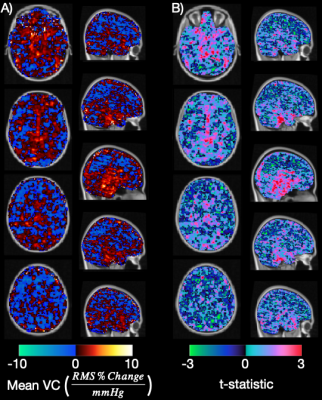 |
Estimating Cerebrovascular Compliance from Normocapnia and Hypercapnia BOLD Pulsatility Mapping
Jake Valsamis1, Nicholas Luciw1, Walter Swardfager2,3, Andrew Lim2,4, Joel Ramirez2, Sandra Black2,4, and Bradley J MacIntosh1,5
1Physical Sciences, Sunnybrook Research Institute, Toronto, ON, Canada, 2Evaluative Clinical Sciences, Sunnybrook Research Institute, Toronto, ON, Canada, 3Department of Pharmacology and Toxicology, University of Toronto, Toronto, ON, Canada, 4Department of Medicine, University of Toronto, Toronto, ON, Canada, 5Department of Medical Biophysics, University of Toronto, Toronto, ON, Canada
Measuring intracranial vascular compliance (VC) may help characterize a patient’s resilience to Alzheimer’s disease and dementia. In this study, we estimate VC from a BOLD MRI cerebrovascular reactivity (CVR) protocol by measuring cardiac-related BOLD pulsatility and end-tidal CO2 during periods of hypercapnia and normocapnia. We measured high VC in regions proximal to major cerebral arteries like the thalamus and insula, and low VC in the parietal lobe. This study demonstrates the feasibility of extracting additional information from BOLD-CVR experiments and suggests regional differences in VC. Future work will include a second cohort to estimate VC in different patient populations.
|
|
| 15:30 | 0490 |
Plug-and-play Advanced Magnetic Resonance Spectroscopy
Dinesh K Deelchand1, Pierre-Gilles Henry1, James M Joers1, Edward Auerbach 1, Young Woo Park1, Firat Kara2, Eva Ratai3, Kejal Kantarci2, and Gülin Öz1
1University of Minnesota, Minneapolis, MN, United States, 2Mayo Clinic, Rochester, MN, United States, 3Massachusetts General Hospital, Charlestown, MA, United States
We developed an automated advanced-single-voxel MRS acquisition protocol at 3T to facilitate acquisition of high-quality spectroscopic data without local MRS expertise. Voxel-based B0 and B1 calibrations were incorporated into the consensus-recommended semi-LASER sequence and combined with automated voxel prescription. Automated B0 and B1 calibrations saved ~4.5min per voxel vs. manual calibrations. All spectra acquired with the automated protocol by rotating MR technologists were usable, while only 83% of those collected with the manual protocol were usable and spectral quality was more variable. The protocol allows automated acquisition of high-quality MRS data with high success rate on a clinical 3T platform.
|
|
15:42 |
0491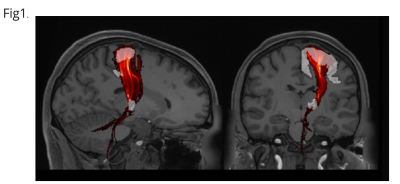 |
Smaller MRgFUS lesions that overlap patient-fit normative VIM—Precentral tracts improve Quality-of-Life outcomes in Essential Tremor
Yosef Chodakiewitz1, David Arnold Purger1, Alan Rehn Wang1, Daniel Barbosa1, Lior Lev Tov1, Anjali Datta1, Rachelle Bitton1, Jennifer McNab1, Vivek Buch1, and Pejman Ghanouni1
1Stanford University, Stanford, CA, United States
While Focused-Ultrasound thalamotomy has proven effective at reducing tremor, traditional targeting methods can be suboptimal at balancing primary tremor-reduction outcomes against undesired side-effects. The traditional “canonical” technique involves an indirect method which applies a non-individualized stereotactic coordinate atlas towards identifying the presumed approximate location of VIM thalamus, the ablation target; the canonical lesion is empirically grown in size based-on dynamic intraoperative feedback from an awake patient, until the surgeon judges that an appropriate balance of tremor-reduction and side-effect risk has been achieved. We propose optimized methods to define and monitor the ideal anatomical ablation for optimized tremor-reduction/Quality-of-Life balancing.
|
The International Society for Magnetic Resonance in Medicine is accredited by the Accreditation Council for Continuing Medical Education to provide continuing medical education for physicians.